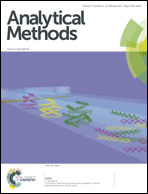In situ electrochemical synthesis of Ni-capped electrochemiluminescence nanoprobe for ultrasensitive detection of cancer cells
Abstract
A facile, novel and in situ electrochemical synthesis of a Ni-capped (NiS@CdS/PANINF) composite electrochemiluminescence (ECL) nanoprobe was developed to fabricate an ECL cytosensor for the ultrasensitive detection of cancer cells. Polyaniline nanofibers (PANINF) films were electropolymerized onto the surface of a bare GCE electrode, and then Ni-capped (NiS@CdS/PANINF) composite nanoprobes were successfully prepared by the in situ electrochemical approach using PANINF as a template. The ECL performance of the proposed nanoprobe showed a ∼5-fold enhancement compared to pure CdS NCs, which were synthesized in an aqueous solution system. Further, aptamer was modified to the electrode surface to fabricate an ECL cytosensor, which was identified as a recognition element of MCF-7 cancer cells. The fabricated ECL cytosensor achieved a wide dynamic range from 12 to 1.2 × 106 cells per mL for the detection of MCF-7 cancer cells, with a low detection limit of 8 cells per mL (S/N = 3). This ECL cytosensor exhibited not only high sensitivity, selectivity and stability but also showed a novel strategy for developing ECL biosensor systems. In addition, it could be extended to the highly sensitive detection of other biological samples.


 Please wait while we load your content...
Please wait while we load your content...